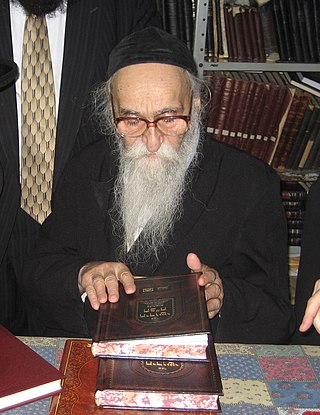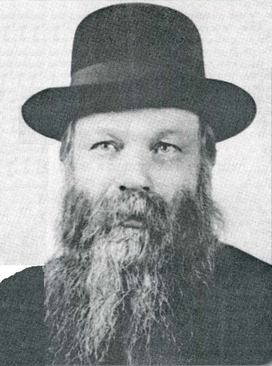
Samson Raphael Hirsch was a German Orthodox rabbi best known as the intellectual founder of the Torah im Derech Eretz school of contemporary Orthodox Judaism. Occasionally termed neo-Orthodoxy, his philosophy, together with that of Azriel Hildesheimer, has had a considerable influence on the development of Orthodox Judaism.
Torah im Derech Eretz is a phrase common in Rabbinic literature referring to various aspects of one's interaction with the wider world. It also refers to a philosophy of Orthodox Judaism articulated by Rabbi Samson Raphael Hirsch (1808–88), which formalizes a relationship between traditionally observant Judaism and the modern world. Some refer to the resultant mode of Orthodox Judaism as Neo-Orthodoxy or in some historiographies as Frankfurter Orthodoxy.

Shraga Feivel Mendlowitz was a leader of American Orthodox Judaism and founder of institutions including Torah U'Mesorah, an outreach and educational organization. In 1921 he became principal of Yeshiva Torah Vodaas, an early day Brooklyn-based yeshiva initially founded as an elementary school in 1918. He subsequently added a high school and post graduate program to the yeshiva. His policies were often informed by the Orthodox philosophical movement Torah im Derech Eretz.
Joseph Breuer, also known as Yosef Breuer was a rabbi and community leader in Germany and the United States. He was rabbi of one of the large Jewish synagogues founded by German-Jewish refugees fleeing Nazi oppression that had settled in Washington Heights, New York.
Torah Umadda is a worldview in Orthodox Judaism concerning the relationship between the secular world and Judaism, and in particular between secular knowledge and Jewish religious knowledge. The resultant mode of Orthodox Judaism is referred to as Centrist Orthodoxy.

Yeshiva Rabbi Samson Raphael Hirsch was founded in New York City in 1944, as a means of reestablishing the Orthodox Jewish community of Frankfurt, Germany in the United States. The school, founded by Rabbi Joseph Breuer, is run according to the philosophy of Rabbi Breuer's grandfather, Rabbi Samson Raphael Hirsch. It is located in the Upper Manhattan neighborhood of Washington Heights.
Chaim Shalom Tuvia Rabinowitz, also known as Reb Chaim Telzer, was an Orthodox Lithuanian rabbi and rosh yeshiva of the Telshe yeshiva. He developed a unique method of Talmudic analysis which became renowned throughout the yeshiva world as the Telzer Derech.

Boruch Ber Leibowitz (Yiddish: ברוך בער לייבאוויץ Hebrew: רב ברוך דוב ליבוביץ, romanized: Boruch Dov Libovitz; 1862 – November 17, 1939, known as Reb Boruch Ber, was a rabbi famed for his Talmudic lectures, particularly in that they were rooted styled in the method of his teacher Chaim Soloveitchik. He is known for leading Yeshivas Knesses Beis Yitzchak in Slabodka and Kaminetz.

Avraham Yaakov Pam was the rosh yeshiva of Yeshiva Torah Vodaas in Brooklyn, New York.

Khal Adath Jeshurun (KAJ) is an Orthodox German Jewish Ashkenazi congregation in the Washington Heights neighborhood, in the New York City borough of Manhattan. It has an affiliated synagogue in the heavily Orthodox Jewish neighborhood of Monsey, New York.

Meshulam Dovid Soloveitchik was a Haredi rabbi and rosh yeshiva of one of the branches of the Brisk yeshivas in Jerusalem.

Orthodox Jewish philosophy comprises the philosophical and theological teachings of Orthodox Judaism. Though Orthodox Judaism sees itself as the heir of traditional rabbinic Judaism, the present-day movement is thought to have first formed in the late 18th century, mainly in reaction to the Jewish emancipation and the growth of the Haskalah and Reform movements. Orthodox Jewish philosophy concerns itself with interpreting traditional Jewish sources, reconciling the Jewish faith with the changes in the modern world and the movement's relationships with the State of Israel and other Jewish denominations.

Shraga Moshe Kalmanowitz was a Polish-American Orthodox rabbi. He was a rosh yeshiva (dean) of the Mir Yeshiva in Brooklyn, New York, from 1964 to 1998.

The Ramailes Yeshiva was an Orthodox Jewish yeshiva in Šnipiškės, Vilnius, Lithuania. It was established in the early nineteenth century, most likely in 1815.

Yeshiva Shaar HaTorah – Grodna, often referred to as the Grodna Yeshiva or simply as Grodna, was an Orthodox Jewish yeshiva in the Belarusian city of Grodno, then under Russian rule. Founded during World War I, Shimon Shkop became rosh yeshiva (dean) in 1920.

After the German invasion of Poland in World War II and the division of Poland between Germany and the Soviet Union, many yeshivas that had previously been part of Poland found themselves under Soviet communist rule, which did not tolerate religious institutions. The yeshivas therefore escaped to Vilnius in Lithuania on the advice of Rabbi Chaim Ozer Grodzinski. In Lithuania, the yeshivas were able to function fully for over a year and many of the students survived the Holocaust because of their taking refuge there, either because they managed to escape from there or because they were ultimately deported to other areas of Russia that the Nazis did not reach. Many students, however, did not manage to escape and were killed by the Nazis or their Lithuanian collaborators.

Shlomo Harkavy, also known as Rav Shlomo Grodner, was an Orthodox Jewish rabbi in Grodno, Poland. He served as mashgiach ruchani of the Grodno Yeshiva under Shimon Shkop, until he was murdered the Holocaust.

Rabbi Pesach Pruskin was an Orthodox Jewish rabbi and rosh yeshiva in White Russia before World War II, most notably in Kobrin. He was known as one of the most brilliant Torah scholars of his time.
Torah Lehranstalt, also known as the Frankfurt Yeshiva or the Breuer Yeshiva, was an Orthodox Jewish yeshiva in Frankfurt am Main, founded in 1893 by Rabbi Dr. Solomon Breuer, the rabbi of the city's seceded Orthodox community.















